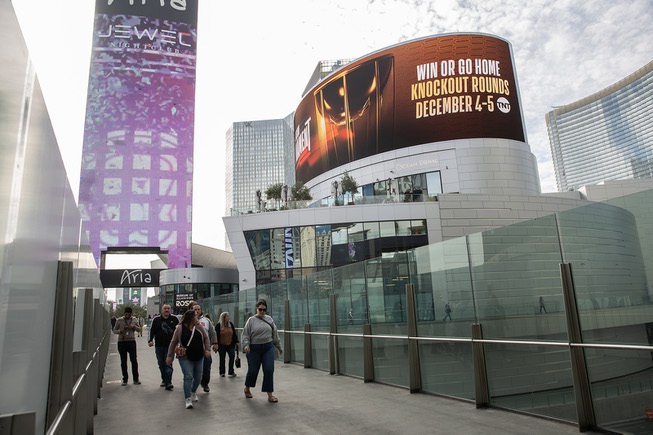
Pedestrians cross over a bridge at Las Vegas Blvd. and Harmon Ave. Wednesday Nov. 29, 2023.
Sunday, Jan. 7, 2024 | 2 a.m.
View more of the Sun's opinion section
Last week, Clark County commissioners unanimously voted to make it illegal to stop or stand still on a pedestrian bridge or within 20 feet of the elevators, stairs or escalators connected to a pedestrian bridge on the Strip. Offenders could face a misdemeanor carrying up to six months in county jail and a fine of up to $1,000.
It’s a harsh penalty, but as Commissioner Jim Gibson and Undersheriff Andrew Walsh described in Tuesday’s meeting, the new law is designed to solve a serious problem: the growing feeling of danger and insecurity for tourists and Resort Corridor workers who rely on the bridges to get around the Strip, and the specific threat of crowd crush posed by the elevated and enclosed walls of the Strip’s many overhead walkways. Crowd crush describes when people become so packed into one area that they can be trampled or suffer other unintentional injuries due to the movement of the crowd.
“When you get right down to it, the unique nature of these bridges and unique nature of this city and the unique nature of Las Vegas Boulevard, when there can be 100,000 people moving up and down the street at the same time and accessing the bridges and moving along as they do, that becomes really important,” Gibson said at Tuesday’s meeting.
He’s right. In a city that relies on tourism for the success of our local economy, the safety of our guests is paramount. So too is the safety of the hard-working Nevadans whose tireless efforts make the Strip work.
We applaud the commission for providing a new tool in the law enforcement toolkit that will help keep people moving, and we hope the new ordinance is successful in making the bridges on the Strip safer and more accessible to all users.
The bridges pose unique challenges, including the challenge of officers on street level to maintain a clear line of sight to the elevated walkways or to respond quickly to potential criminal activity. Walsh noted that this problem was exacerbated when people stand on the bridge and block sightlines for long periods of time.
William Sousa, a professor in UNLV’s department of criminal justice, analyzed data related to the pedestrian bridges from Metro Police’s Research and Analysis Unit and found that while the bridges account for less than 6% of the total length of the sidewalk system in the Resort Corridor, they account for almost 11% of calls for disorderly conduct such as fights, public intoxication, public drug use and suspicious persons.
With that said, the devil is in the details, and it is incumbent upon all parties — Metro, the County Commission, resort workers and anyone who calls Las Vegas home — to ensure the law is enforced fairly and is not abused.
To that end, Commissioner William McCurdy called on Metro to provide additional training for officers assigned to the Resort Corridor to ensure they understand that the ordinance is not intended to target any specific group of people but should be applied equally to anyone who impedes the flow of pedestrian traffic.
We also encourage the commission to pass a proposal made by Commissioner Tick Segerblom that would require Metro to keep a log of all enforcement actions on the Strip, helping to ensure that the new ordinance is not used to target specific people with specific identities, occupations or appearances, but rather is enforced for its intended purpose: keeping traffic flowing.
Finally, rather than relying so heavily on imposing penalties against offenders, the commission should look to dissuade criminal activity on the Strip by providing Metro with the necessary funding to ensure a sufficient number of officers are highly visible, present and responsive to any criminal activity on the Strip — including on the bridges.
